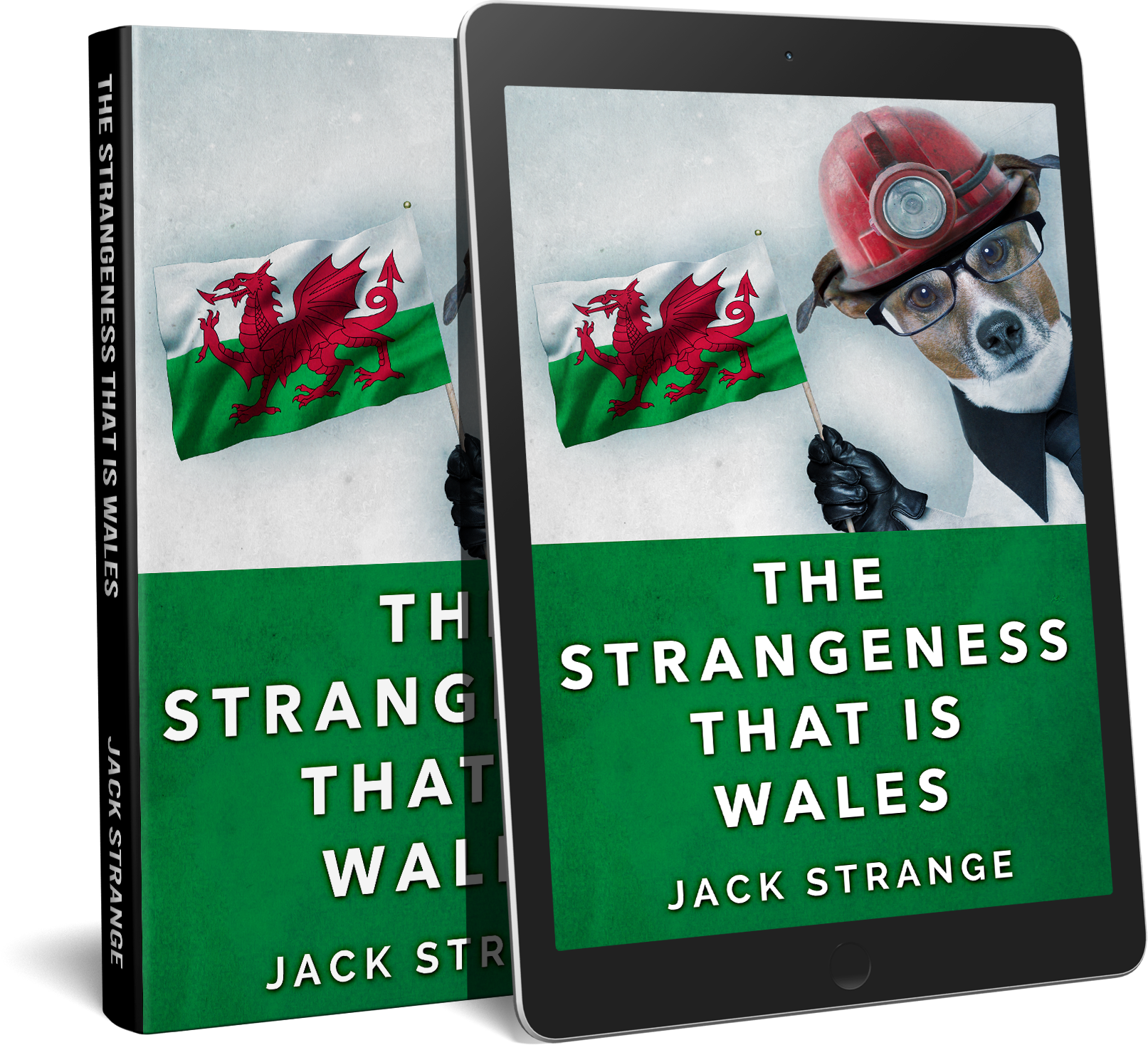Discover The Secrets Of Welsh History, Folklore And Mythology
The Strangeness That Is Wales (Jack's Strange Tales Book 3) by Jack Strange
Book excerpt
Ynys Mon, otherwise known as Anglesey is Wales’ largest island at 276 square miles. It is a place worth a few days of anybody’s time for the strangeness that is woven into the atmosphere and fabric of the island. Some may not see it, but for those with the ability, or the power, to sense what lies beneath the surface, Anglesey is a place unique and sometimes even disturbing. First, a short paragraph about the name.
Anglesey sits on the North West coast of the country, and with Thomas Telford’s Menai Suspension Bridge and the Britannia Bridge connecting her to the mainland, may not be considered a true island any longer. Many people will hotly and quite justifiably dispute that claim. The origin of the name is also disputed, with some saying that Ynys Mon could mean the Island of Mon, with Mon being a Welsh princess. Sometimes the island is known as Môn, Mam Cymru, Mona, the Mother of Wales, or could take her name from an ancient goddess named Modron, the Mother of Wales. You pays your money and takes your choice.
Some hopeful people think that Anglesey may have been the Arthurian Avalon, from the Welsh Afallach, - bountiful in apples. Apparently, in the early Celtic period, Anglesey was famed for its apple production. The 12th-century cleric and author Geoffrey of Monmouth certainly named Anglesey Insule Ponorum, Island of Apples.
The first time I visited Anglesey it was raining, a thin drizzle that smeared across the Menai Strait and drained all colour from the island. Even so, there was no doubting the drama of the place. This island has an atmosphere that transcends rationality. For those with the ability to empathise with a sense of place, Anglesey is hard to beat. The feeling of the old long-gone people who were here is tangible; it is in the fields and the ancient stones, it creates the island as much as the landscape for this was the home of the Druids.
The human population of the island stretches back for many centuries to pre-history, with a variety of menhirs (upright standing stones) and cromlechs (megalithic altar-tombs). It has been said that Anglesey has more ancient sacred monuments per square mile than anywhere else in Britain. They are everywhere. For example, the burial chamber at Bryn Celli Ddu is fascinating with its passage into the mound while the standing stones at Din Dryfol are an invitation to wonder.
So where are the Druids? They were not involved with raising these ancient stones, yet it was as a Druidical religious centre that Anglesey entered recorded history. When the Romans invaded Britain, they rolled up the tribes in what was now southern England but found resistance stiffer as they marched north and west. In what is now Wales the tribes of the Ordovices, Silures and Demaete were tough to face. The Roman juggernaut, victorious from the banks of the Euphrates to Nubia and from the Atlas Mountains to the Aral Sea, stalled at the Welsh frontier.
The Romans found that the Druids, the religious order of the Celts, organised the resistance against them. Rome was fascinated by the Druids, and Roman writers mention the Druidical oral knowledge and their influence as priests, healers, divines and seers. The chief centre of the Druids was on Anglesey, so around AD 61, General Gaius Suetonius Paulinus marched an army to remove this religious menace.
So who or what were these Druids that required an entire army of the most successful military power in the world to subdue? Well, the truth is that nobody is sure. There are various rumours and wild speculations, but as the Druids left nothing in writing, historians have to rely on the words of the Druids’ enemies, which is never a reliable source. We know the Druids were a dominant religious force that seemed to surmount any tribal loyalty and as such were the glue that bound the Celtic peoples together. Perhaps because of the presence of the Druids, Anglesey became a haven for refugees escaping Roman rule and possibly also a rallying place for warriors desperate for the opportunity to strike back. It is significant that the Romans only persecuted two religions, presumably those that they viewed as a threat. One was Christianity, and the other was Druidism, which speaks volumes for the power and influence of the Druids.
Tacitus, a Roman writer, gives the only recorded account of what happened when Suetonius Paulinus:
Prepared accordingly to attack the island of Mona, which had a considerable population of its own, while serving as a haven for refugees; and, in view of the shallow and variable channel, constructed a flotilla of boats with flat bottoms. By this method the infantry crossed; the cavalry, who followed, did so by fording or, in deeper water, by swimming at the side of their horses.
So much for the Romans. On the Druid’s side:
On the shore of Anglesey stood the adverse array, a serried mass of arms and men, with women flitting between the ranks. In the style of Furies, in robes of deathly black and with dishevelled hair, they brandished their torches; while a circle of Druids, lifting their hands to heaven and showering imprecations, struck the troops with such an awe at the extraordinary spectacle that, as though their limbs were paralysed, they exposed their bodies to wounds without an attempt at movement. Then, reassured by their general, and inciting each other never to flinch before a band of females and fanatics, they charged behind the standards, cut down all who met them and enveloped the enemy in his own flames.
It sounded more like a massacre than a battle as the veteran, professional Roman soldiers slaughtered the priests, warriors and women of the Druids. Once the Romans had disposed of the Druids, they set about cutting down the sacred groves. According to Tacitus – hardly an unbiased writer - the Druids sacrificed people within the groves and used human entrails to foretell the future. Is this true? Imperialist armies often use propaganda to justify their actions, showing their enemy in the worst possible light. Without a corresponding account from the British point of view, we cannot tell fact from downright lies. What we do know is a mixture of supposition and guesswork mingled with Roman writings and archaeological finds (with apologies to any modern day Druid who may somehow have genuine knowledge of the subject.)
I have read stories of Druids hiding in trees to cut off the heads from marching Roman soldiers. I have never seen these accounts in trustworthy primary sources. Perhaps I have looked in the wrong places.
The Druids seem to have been nature worshippers, with trees central to their beliefs. Yew and oak trees were especially important, and some people believe that the word Druid, Derwyddon in Welsh means ‘oak knowledge’. Others believe it means ‘forest sage’ or ‘strong seer’. While human sacrifices may be only a Roman invention, there is no doubt that other objects were religiously sacrificed in Anglesey.
When Llyn Cerrig Bach (Lake of the Small Stones) was drained in the 1940s to make an RAF runway, it was found to contain many ancient artefacts from swords and spears to cauldrons, a trumpet and currency bars. The ominous inclusion of slave chains is as a reminder that the Celts were not an innocent pastoral people who indulged only in nature worship, but a warlike society with their own dark side. However, compared to the Roman culture of industrial slavery and ritual sacrifice in their euphemistically styled ‘games’ the Celts were relatively innocent. The Roman Colosseum was only one of a large number of amphitheatres where animals and humans were sacrificed in unpleasant ways to provide entertainment for a people who were a long way from our notion of civilisation. Perhaps the Romans lived in cities, but cities based on slavery. The Druids would know the reality of Rome, where defeat meant subservience to a brutal new society; it is no wonder they resisted so fiercely.
We do not know how effective the Roman attack on Anglesey was in ending the power of the Druids. We do know that Druidism as a religion survived, for when Saint Columba travelled through the lands of the Picts he met Druids. There is no doubt that Druidism persisted then, in some form, even after Rome’s ravaging of Anglesey. The Druids peep out of the pages of this book now and then and many of us, knowingly or unknowingly may possess some Druidic lore.
The Druids were not only in Anglesey, of course. Not far from
Penmaenmawr on the North Wales coast, there is a circle of low stones sometimes called the Druid’s Circle. In the centre of the circle was a cist, which contained the body of a child. The circle also has the Deity Stone, which thumps anybody who dares to use bad language beside it. I did not try that, just in case. Nearly directly opposite is the Stone of Sacrifice, which has a curious small depression on the surface. The story goes that if a mother lay her very young baby within the depression, he or she would have a life of good fortune. Apparently, on wild nights yells and cries come from the Stone of Sacrifice and according to legend, there was once a witches gathering at these stones where some of the witches touched the stone. Two apparently died, and another lost her mind. Were the Druids involved? Or is this just a scare story? Probably the latter.
I will take a slight leap now to a man who reinvented Druidism for the modern world. His name was William Price, and he was a Welshman, he was born in Wales, lived in Wales, lived for Wales and left an indelible mark that continues today. Born in Rudry near Caerphilly in March 1800, William Price is remembered for his part in pushing neo-Druidism, although he was also a medical doctor, a Chartist, a Welsh nationalist and a proponent of cremation.
Although Welsh, Price’s father was a Church of England priest, who had married a Welsh maidservant. Such a class-crossing union was frowned on in respectable circles and may have influenced young William Price in his life choices. It is also possible that eccentricity was in his genes, for Price’s father had his moments of strangeness, including bathing in local ponds, with or without clothes and carrying a pocketful of snakes.
After training as a doctor in London, William Price returned to Wales in the 1820s. After a few years at Glyntaff near Pontypridd, Price moved to a farm at nearby Upper Boat and then took on a position as chief surgeon at the Brown Lenox chain works, also near Pontypridd. In 1823 he moved to Treforest. All these villages were in industrialised areas, where working men clustered together in poor conditions. In Treforest, Price judged the Eisteddfod’s competition for a bard and joined in the People’s Charter movement, which aimed at significant suffrage improvements. Price also gave Welsh lessons to counter the spread of the English language in Wales and joined a Neo-Druidical group named the Society of the Rocking Stone. The Society of the Rocking Stone held their meetings Y Maen Chwyf, a large stone within a circle that had a history of Neo-Druidism rather than a deep understanding of the original Druids.
Book Details
AUTHOR NAME: Jack Strange
BOOK TITLE: The Strangeness That Is Wales (Jack's Strange Tales Book 3)
GENRE: History
SUBGENRE: Welsh History / Folklore & Mythology
PAGE COUNT: 205













Praesent id libero id metus varius consectetur ac eget diam. Nulla felis nunc, consequat laoreet lacus id.